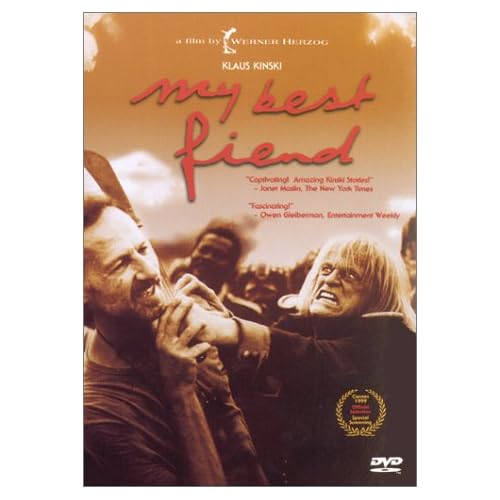by Tom Bissell
Harper's Magazine

Herzog’s ecstatic truth finds its way into his feature films as well. The Enigma of Kaspar Hauser fictionalizes the real story of a young man who turned up in a nineteenth-century German town with scarcely any speech and no experience with the outside world, for he had been kept chained in a cellar, by unknown parties, for the first two decades of his life. In the role of Kaspar, Herzog cast a nonprofessional actor, the incomparable Bruno S., who was in actual fact a prostitute’s son who had spent twenty-three years in various institutions, where he was often beaten and kept in deep isolation.

In Stroszek, the story of a luckless German street musician who travels to the American Midwest to improve his life, and fails miserably, Herzog uses Bruno S. again. The film’s most disturbing scene involves Bruno S.’s character being beaten by pimps in his apartment, which Herzog chose to film in Bruno’s actual apartment. This sequence, Herzog has admitted, “pains me so much because it was probably the kind of treatment that had been doled out to him for years when he was a child.” Two other sequences offer equally startling but far less brutal ecstatic truths: a scene in which Bruno talks to his prostitute girlfriend about life in America (under the Nazis, Bruno says, they beat you and cursed you, but in America, “They do it ever so politely, and with a smile”) was improvised, reflected what Bruno S. himself felt upon his first trip to the United States, and results in what is perhaps the most intimate moment in the film.
For another sequence, Herzog flagged down two Wisconsin deer hunters and asked them if they would agree to be filmed while one of his elderly German actors spoke to them in German. They agreed, and Herzog turned on his camera. After listening for a few moments to this strange little German discuss the power of “animal magnetism,” the deer hunters look at each other, laugh, get into their car, and quickly drive away. Herzog never saw the deer hunters again. It is one of the funniest sequences in any of Herzog’s movies.

For Aguirre: The Wrath of God (1972), a violent, troubling film about a breakaway expedition of Spaniards searching for El Dorado along the Amazon River while gradually going mad, Herzog filmed on the Amazon with a cast and crew who nearly went mad. The reality of the shoot constantly intrudes into Aguirre’s story. When the raft he was filming on developed a mouse infestation, Herzog filmed the mice. When part of the raft was in danger of being sheared off by low-hanging branches, Herzog scrambled for his camera, captured the collision, and incorporated it into the film, which ends with the megalomaniacal Aguirre (played by the megalomaniacal Klaus Kinski) coming to grief on a raft crawling with spidery little monkeys. While Aguirre wanders about his raft, his comrades dead, his mind slipping past the final checkpoints of sanity, he delivers a mad speech—parts of which Herzog says incorporate an equally mad speech delivered by the Zanzibari revolutionary John Okello—while the monkeys skitter around him.

In Fitzcarraldo (1982), Herzog again tells the story of a dreamer searching for salvation in the Amazon. Fitzcarraldo’s doomed quest to bring opera to the Amazon requires dragging a 340-ton ship over a mountain to reach an inaccessible river; Herzog naturally decided that he would actually drag the ship over the mountain. The film thus becomes an allegory of itself. Herzog spent three years in the jungle making Fitzcarraldo, and in the process had to deal with scrapping everything halfway through when his original star, Jason Robards, fell ill with dysentery and was forbidden by his doctor to return to Peru; plane crashes; a border war between Peru and Ecuador; Herzog’s arrest by the authorities; several crew members’ injuries (including one man chainsawing off his own foot after being bitten by a poisonous snake); and attacks by hostile Indians (one of which resulted in two members of the production undergoing eight hours of surgery). When the time came to recast Fitzcarraldo’s leading man, one might have expected Herzog to opt for an actor with peace at the center. Herzog, however, cast the miracle of ill temper that was Klaus Kinski, even though he knew Kinski “would freak out” and “go totally bonkers” in the jungle. Kinski did not disappoint.

Yet Herzog continued working with Kinski—they eventually made five films together—and in this, one can detect something of the perversity that impelled the director to drag a boat across a mountain in the first place. Herzog has never really been able to fully account for his and Kinski’s twisted reliance upon each other. He did pull from Kinski some astonishing performances—particularly in Woyzeck, a film basically composed of several long one-take sequences—but their working relationship involved serial pledges to kill each other. Kinski, who died in 1991, wrote in his autobiography that “I absolutely despise this murderous Herzog. . . . Huge red ants should piss into his lying eyes, gobble up his balls, penetrate his asshole, and eat his guts!”
To Read the Entire Essay
No comments:
Post a Comment